5 Crucial Factors To Consider When Purchasing Aluminum Bleachers
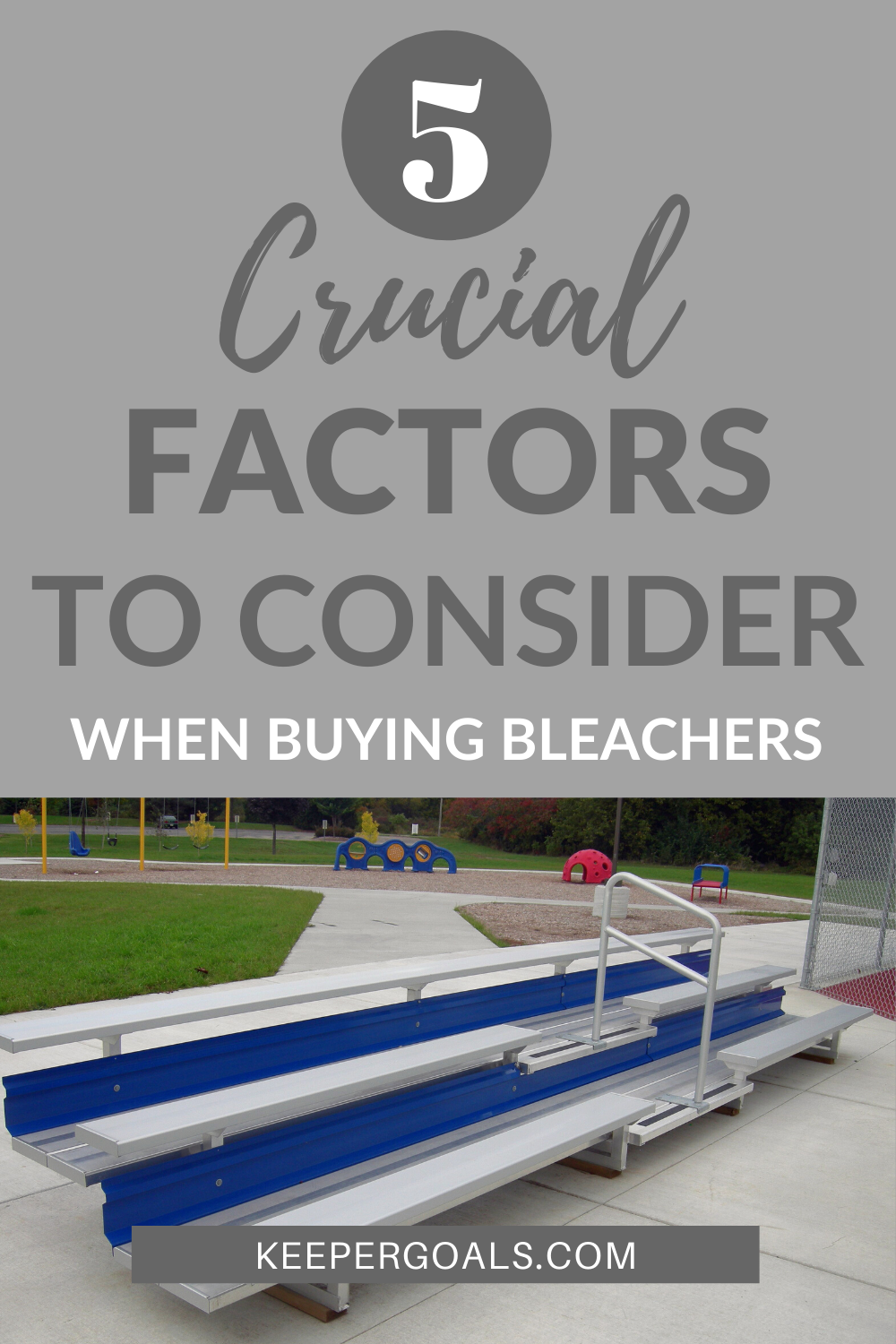
By Steve Lawrence –
Outdoor bleachers are an important part of any type of athletic or park facility. Today we will focus primarily on aluminum bleachers from 2-rows up to 15-rows.
Having young kids involved in sports myself, I have been going to more and more athletic facilities lately. I am always grateful to have somewhere to sit to enjoy the game I’m watching. However, now that I’m working in the sporting goods equipment and site furnishing industry I’m learning there are a lot of decisions to make when purchasing smaller bleachers for an athletic facility, park or school.
Let’s take a deeper dive into 5 important factors you’ll want to consider to help you identify the best bleachers for your athletic facility. We’ll also discuss some of the most popular types of accessories that could enhance the look and function of your bleachers.
The 5 factors we’ve identified for you to consider to help you find the right bleachers are; your budget, the number of individuals you wish to seat, the quality of bleacher you will need, compliance with local building codes, and any accessories you many need to purchase.

#1 – Budget
Understandably budget can often be a major factor in determining what type of bleachers you will purchase. However, it’s important to understand why certain bleachers cost more than others so that you can make a good long term decision. If you purchase a bleacher that needs to be replaced every few years, but you will need the bleachers for many years, then you may be paying more in the long run. You may want to consider a bleacher that will cost a bit more upfront but will last longer, thus saving you money long-term.
As you will find out reading further into this article, there are other factors you will want to consider besides the price of the bleacher. Hopefully, we can help you learn why some bleachers cost a little bit more than others. Once you have this understanding you can then review your options to begin to evaluate what best fits into your budget, and ultimately makes the most sense for you to purchase. There is usually a reason some bleachers cost more than others, so it’s important to find out the why so you can determine if the cost is worth it or not.
View Keeper Goals wide variety of bleacher offerings to meet all budgets.

#2 – Number of Spectators to Accommodate
For larger bleacher projects (over 15 rows) you will work with an architect and often a sporting goods equipment company to understand the area you have to work with. You’ll rely on them to help determine the number of seats you can fit in the space you have available in your stadium or large facility.
However, when looking for bleachers 15 rows and smaller for your facility it’s important to understand approximately how many individuals can be seated on various bleachers. There are numerous factors to consider including the rise and run between each row and if an aisle is included or not.
The charts below give you estimated seating capacities for several popular sizes of IBC Compliant bleachers. Before you view the charts, I encourage you to think about the first row of the bleacher and the impact it can have on seating capacity. If the first row is less than 12” from the ground, then more than likely adults will have a difficult time sitting in the first row. It will be too low to the ground for them. It will get used more as a step than a seat. These types of bleachers are referred to as “low-rise bleachers”. So, if you purchase a low-rise bleacher and you will have adults sitting on them you may not want to count the first row into your total number of spectator seats. For example, if you purchase a low-rise 19′ three-row bleacher that states it seats 32 people, or approximately 10 seats per row, (based on the industry standard of 18 inches per seat space), and you will have adults sitting on them, you may want to estimate the actual seating capacity at 22 people instead of 32. (Note: If younger kids are the main audience sitting in the bleachers then you are probably safe to estimate the seating capacity at 32 on a low-rise 19′ 3 row aluminum bleacher.) Whereas if you purchase a bleacher with the first row greater than 12″ from the ground you can safely estimate the seating capacity at 32 for both children and adults.
Bleachers seating capacity charts (Numbers based on standard 18 inches per seat space)
IBC Compliant Bleachers – no ADA slots, includes aisle
| 19 ft | 25 ft | 31 ft | |
| 3 row | Seats 32 | Seats 44 | Seats 56 |
| 5 row | Seats 52 | Seats 72 | Seats 92 |
| 8 row | Seats 82 | Seats 114 | Seats 146 |
| 10 row | Seats 102 | Seats 142 | Seats 182 |
| 15 row | Seats 152 | Seats 212 | Seats 272 |
IBC Compliant – with ADA slots, includes aisle
| 19 ft | 25 ft | 31 ft | |
| 5 row | Seats 48 & 4 ADA | Seats 68 & 4 ADA | Seats 88 & 4 ADA |
| 8 row | Seats 78 & 4 ADA | Seats 110 & 4 ADA | Seats 142 & 4 ADA |
| 10 row | Seats 98 & 4 ADA | Seats 138 & 5 ADA | Seats 175 & 5 ADA |
| 15 row | Seats 148 & 4 ADA | Seats 205 & 5 ADA | Seats 265 & 5 ADA |

#3 – Quality
Quality is obviously an important factor when purchasing a bleacher. Do your research when it comes to finding the bleacher with the best quality. Over time people will step on bleachers, spectators will jump on them, bleachers will get moved around, etc., so you want to make sure you have a durable product that lasts. Consider the following when determining the quality of a bleacher:
- Strength of framing – Due to longevity, we suggest only considering bleachers utilizing aluminum frames. There are two types of aluminum framing to consider, tubular frames and angle frames. Bleachers utilizing tubular frames require less cross bracing, are more durable and are much easier to assemble. The lack of cross-bracing makes them much easier to clean and maintain under the bleacher, as well. Angle-frame bleachers require multiple cross-braces, are not as durable and cost significantly more to install. They also require significantly more connection points which make yearly inspections more difficult and more opportunity for connection bolts to loosen.
- Seat Plank and footboard strength – Different bleacher manufacturers provide different plank profiles. We strongly recommend using bleacher manufacturers that utilize .085” or more as a wall thickness of their plank. Seat and footboard planks with thinners walls than .085” are proven to fail over time. All bleacher manufacturers should list their plank wall thickness with their technical specifications.
- Transportability Durability – If you want a bleacher that you can move to different fields then the strength of framing becomes that much more critical. You want to make sure that when you are pulling the bleacher (using a Hitch and Wheel Kit for example) that it won’t cause damage to your bleachers when moving.
- Warranty – You can normally tell how long the company feels their product should minimally last based on the number of years of a warranty. Also, when looking at the warranty ask what is covered under it and what is not, as this isn’t always clear.
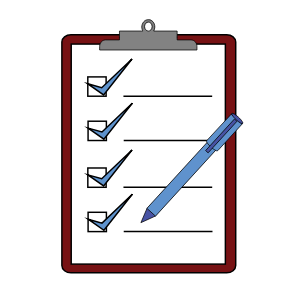
#4 – Compliance
One area that cannot be overlooked with outdoor bleachers is making sure they are safe and compliant. If you purchase a bleacher that is not compliant in your state, you run the risk of having to replace the bleacher entirely if they get inspected. So its important when looking into the purchase of outdoor bleachers that you confirm the bleachers you want to purchase meet compliance standards in your state. The majority of states follow the compliance standards set by the International Building Code (IBC), which date back to safety standards that were set by the Consumer Product Safety Commission (CPSC) in 1999 (and continue to be updated since then). The IBC is part of the family of code put in place by the International Code Council (ICC). The ICC is a nonprofit association that provides a wide range of building safety solutions. These standards were put in place to help provide more safety on bleachers as a result of various injuries that occurred prior to 1999 usually involved kids on bleachers.
A few of the key compliance rules the IBC has requirements for when it comes to outdoor bleachers are listed here:
| Bleacher Component | Rule | Interpretation |
| Footboards and Risers | IBC Code Section 1008.14
Bleacher footboards shall be provided for rows of seats above the third row or being at such a point where the seating plank is more than 24 inches above the ground or floor below. Where footboards are more than 30 inches above grade, openings between the seat and footboards shall not allow the passage of a sphere greater than 4 inches |
Area below 24 inches from the ground do not require a footboard
Double foot boards and risers are needed when you get 30 inches from the ground to prevent an opening less than 4” (ask vendor for spec drawings if you want to confirm heights). Will apply to bleachers 3-rows or higher. |
| Guards | IBC Code Section 1003.2.12
Guards shall be located along open-sided walking surfaces, platforms and landings which are located more than 30 inches above the floor or grade below. Guards shall also be located along sides of stairways and landings that are located more than 30 inches above the floor or grade below. |
For bleachers that have a last row that is higher than 30 inches from the ground you will need to have a guard behind it and down each side to the 30-inch point. This will become relevant for any bleacher above 3-rows. |
| Aisle | IBC Code Section 1008.8
An aisle is not required in seating facilities where all of the following conditions exist: 1. Seats are without backrests. 2. The rise from row to row does not exceed 6 inches (152 mm) per row. 3. The row spacing does not exceed 28 inches (711 mm) unless the seatboards and footboards are at the same elevation. 4. The number of rows does not exceed 16 rows in height. 5. The first seating board is not more than 12 inches (305 mm) above the ground or floor below or a cross aisle. 6. Seatboards have a continuous flat surface. 7. Seatboards provide a walking surface with a minimum width of 11 inches (279 mm). 8. Egress from seating is not restricted by rails, guards or other obstructions. |
If you do not want to have an aisle in your bleacher you will need to go to a “low rise” bleacher. These bleachers have a first row where the bleachers are 12 inches or less (making it very low to sit in), and the rise from row to row will be reduced from the standard 8 inches to 6 inches (impacting the spectators viewing ultimately). |
As you can see from the IBC rules above, they are looking out for the safety of spectators. Ultimately though, the customer is responsible if they purchased a non-compliant bleacher so I would recommend that you make sure to work with a reputable company that puts an emphasis on compliance and following IBC rules in the bleachers they offer. If you find a bleacher that is much less expensive than others you more than likely should start checking to see if they are including double footboards, guardrails, and aisles to meet compliance. Check out Keeper Goals offering of IBC compliant bleachers.
#5 – Accessories For Aluminum Bleachers
Once you have your bleacher you should determine what accessories you can add to the bleachers to provide benefit to you and potentially your spectators. Although this will add to the price of bleachers, it may be worth the money when it comes to enhancing the look of the bleachers or provide more advantages to the purchaser. The following are some accessory options we have found beneficial and worth looking into;
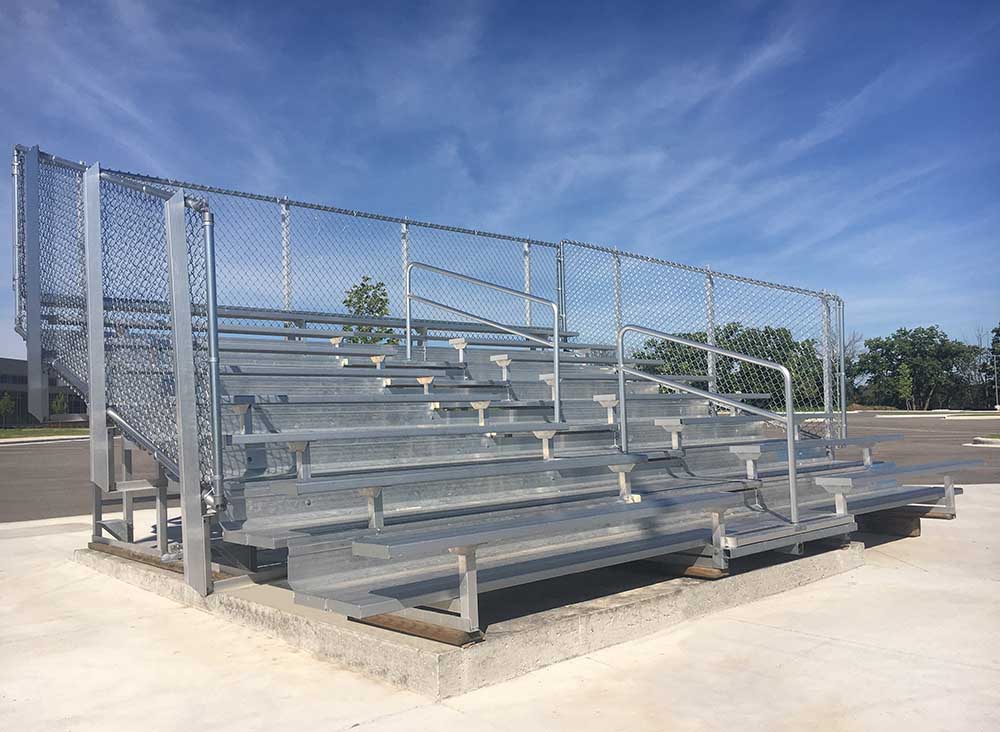
Guards and Rails
When purchasing bleachers 5 rows or higher, you will want to add guarding around the top of the bleachers as well as on the sides of the bleachers to protect those spectators seated there and to meet IBC Code standards (see the compliance section of this article below for more details on specific height requirements).
Click here to see some examples of bleachers with guards and rails. A variety of guards and rails are available including custom railings.
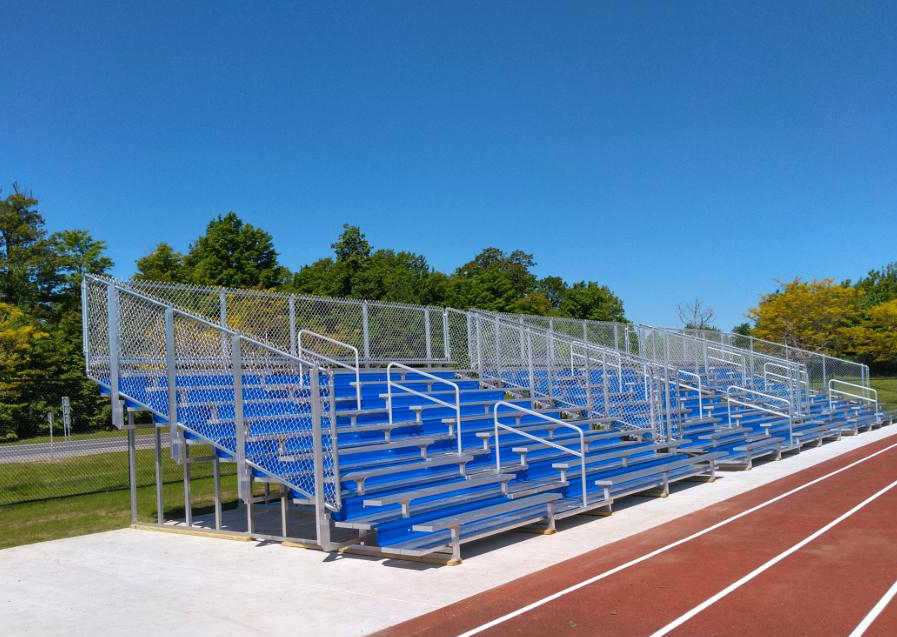
Double Footboards & Risers
By adding double footboards and risers you can help prevent individuals from dropping items accidentally under your bleachers. There is nothing more annoying than having to go under bleachers to get an item that fell through the cracks. Also, once you get 30 inches from the ground these will become required to meet IBC standards as stated earlier in this article.
Furthermore, you can powder coat footboards and risers a wide variety of colors to make your bleachers look nicer or represent the color branding of your school. Click here to see a few more examples of a bleacher with double footboards & powder coated risers.
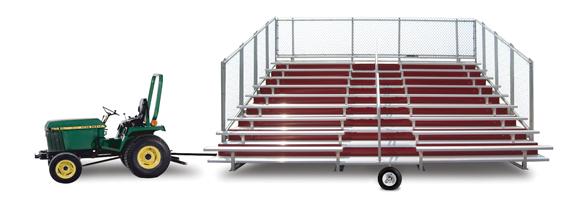
Hitch & Wheel Kits or Tip & Roll Kit
If you have a facility where you want to have the luxury of moving the bleachers from one area to another (ie. in the fall they are at the soccer field, and in the spring they are at the baseball field), then a hitch and wheel kit will be your best option.
You can find these Hitch and Wheel Kits for 3-row, 5-row, 8-row, and 10-row bleachers. Also, if looking for a 3-row bleacher to move around indoors you can go with a Tip & Roll Kit for 3-row bleachers.
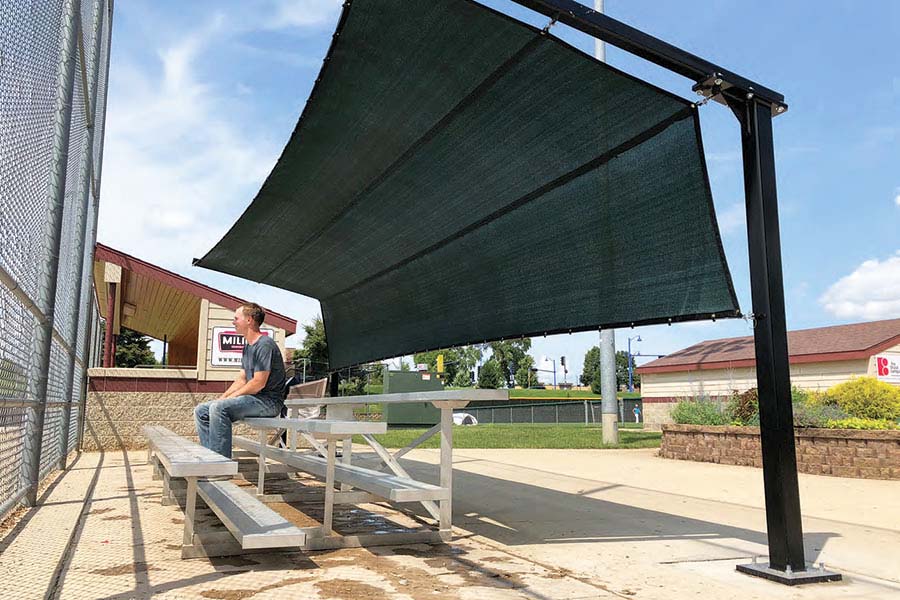
Bleacher Defenders
The bleacher defender provides an affordable option to cover 3-row and 5-row bleachers to provide much-needed and much-appreciated shade many facilities do not have.
Furthermore, if your bleachers are used for baseball or softball, the bleacher defender also would serve as protection for your spectators from errant balls.
Bleacher Defenders can be a unique way to set your facility apart and are available in black, green and royal blue.
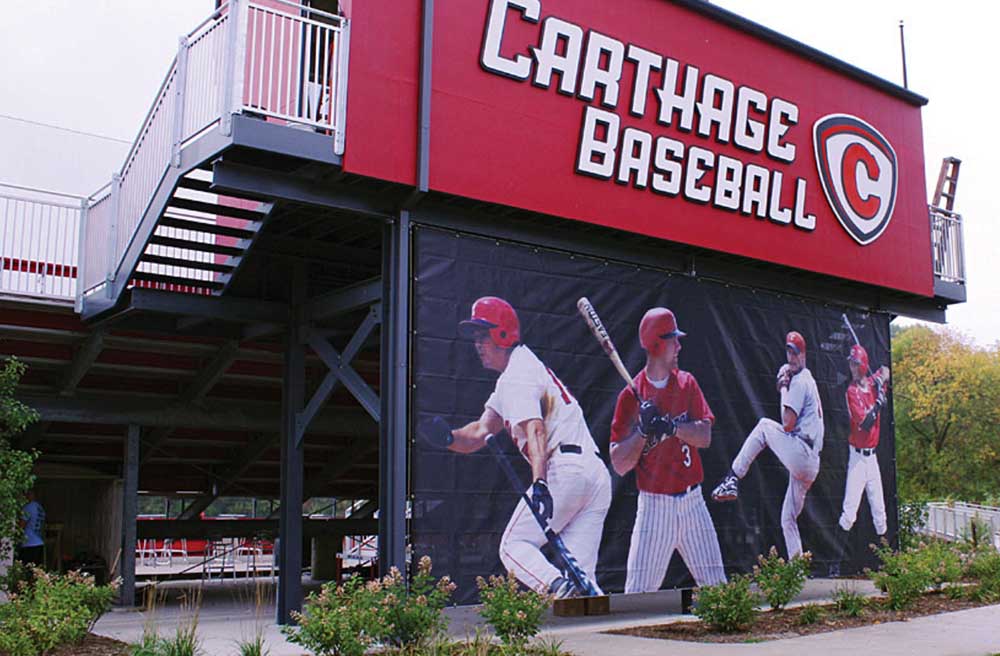
Bleacher Wrap
Rather than having people see the framing and bracing below your bleachers, let them see a fully digital image that represents your school or clubs brand.
Using bleacher wrap to cover the backs and sides of bleachers is an easy and cost-effective way to brand your facility’s bleachers. Bleacher wrap will also allow you to provide cover to prevent kids from climbing on the cross-bracing on the backside of your bleacher unit and preventing possible injuries.
To obtain a free quote on bleacher wrap from Keeper Goals, send us the dimensions of the areas on the bleacher you want to be covered and provide a picture of the bleacher areas requested to be covered. The picture is important so we can determine where the bleacher wrap can be connected to, which will dictate pricing for installation.
Email us or give us a call at 800-594-5126 M-F 8am-5pm CST. We can help you find the aluminum bleachers that fits your needs for your school or sports facility.

